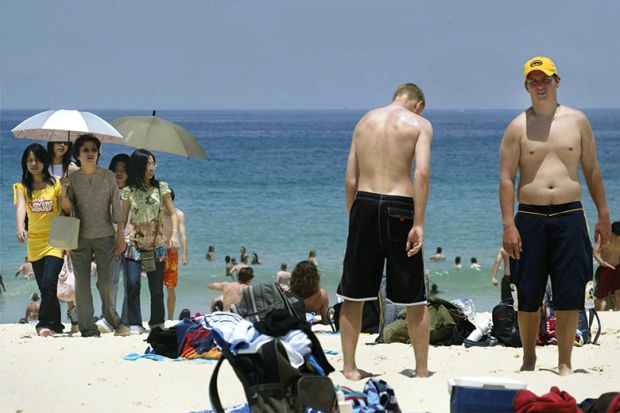Outside Sydney’s central station more than 150 students are waiting for the 891 express bus service to the University of New South Wales.
The enormous queue is not due to any lack of buses – a shuttle leaves the stop every three minutes at peak time – but is the consequence of the sheer weight of students heading to the university’s campus four miles away, close to the international surfing mecca of Bondi Beach.
Apart from its length, the other striking thing about the bus queue is its ethnicity: nearly everyone in it is of Asian or Indian heritage. Even for one of the world’s most multicultural cities, where 40 per cent of residents were born overseas, the 891 bus is still a striking reminder of the major role that students from China, Southeast Asia and India are playing in Australian higher education.
That role looks likely to grow further in the coming years given the mixed signals that Australia’s two main competitors for overseas students are sending to the world: Donald Trump’s “America First” mantra and so-called Muslim ban, and Brexit and Theresa May’s vow to tighten student visa rules. And there is an argument that increased Asian recruitment is crucial to cementing Australia’s growing integration into the Asia-Pacific economy. In that regard, it is also worth noting that the movement is not all one-way. The country’s government-funded New Colombo Plan, launched with a fanfare in 2014, currently sends up to 150 Australian undergraduates to study or do internships in Asian countries, on scholarships of up to 12 months. The aim, according to the government, is to “lift knowledge of the Indo-Pacific in Australia”.
But there are also concerns. Some see increased Asian recruitment as a risk to the quality of university teaching in Australia, undermining the very “Australian experience” that Asian students seek and perhaps even stoking a sense that multiculturalism is delivering little benefit to ordinary Australian families.
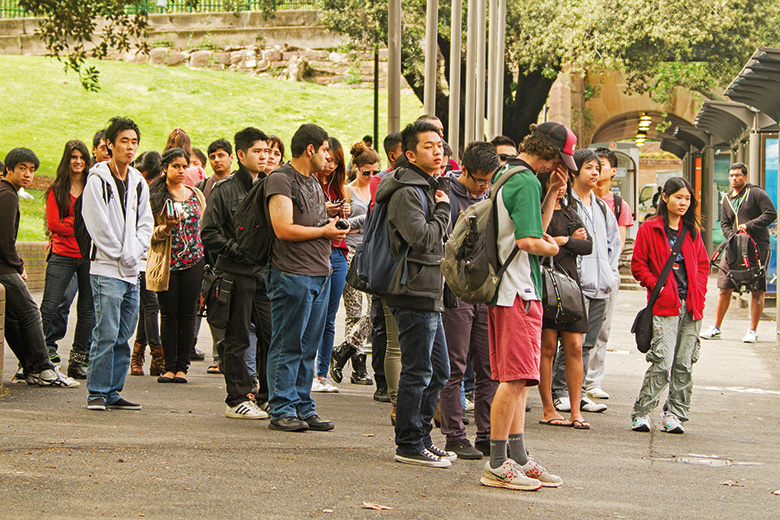
On the University of New South Wales’ campus next to the grassy slopes of Randwick racecourse, signs of Asian students’ influence are obvious. Below the eucalyptus trees in one of its quads, a Malaysian students’ society is selling hot snacks to passers-by, while the university even has its own Korean pop dancing group for those looking to perfect their Gangnam Style moves.
In total, about 16,000 of its 55,000 students are from overseas, mostly Asia and India. That number exceeds the entire student body of many medium-sized UK universities, observes the university’s vice-chancellor, Ian Jacobs, who arrived from the UK in February 2015, having previously held senior roles at the University of Manchester and University College London. “Australia is looking to educate the world and is very well poised to do so,” he says, agreeing that the “tectonic plates are shifting” in Australia’s favour thanks to Brexit and Trump.
His analysis is borne out by official government statistics, which reveal that international student numbers in Australia grew by 15 per cent to 480,000 in the year to March 2017, with 280,000 of those in higher education. Numbers from China alone were up by 20,000, hitting 140,000.
The “soft power” benefits of educating this volume of Chinese students are also starting to emerge as older Australian-educated Chinese graduates reach influential positions in business and politics, says Jacobs, adding that some New South Wales-educated Chinese chief executives are looking to invest millions of dollars in research at their alma mater. And, in April 2016, the university secured A$30 million (£17 million) of investment from the Chinese government for a new A$100 million science and technology precinct: the first time China has located one of its state-backed Torch innovation hubs outside its own borders, says Jacobs.
That type of investment, allied with buoyant international recruitment, has allowed the University of New South Wales to spend an extra A$3 billion on staff up to 2025, recruiting 100 top research professors and around 300 early and middle-career “scientia fellows” with the aim of becoming the first Sydney university to be ranked among the top 50 universities worldwide.
But while Australian students at the University of New South Wales appear to be generally supportive of the highly internationalised student body, some admit to frustrations. One bugbear is the difficulty of interacting with international students, who often form their own friendship groups – although that situation is also not helped by the fact that most Australian students commute from their family homes since they are unable or unwilling to pay Sydney’s sky-high rents.
Jim Hansen, a final-year civil engineering student, says he has never interacted with a “big proportion” of his classmates. “That said, I am tutoring some international students, which helps to pay my tuition fees,” he adds.
Meanwhile, law student Khushaal Vyas admits that some overseas students find it more difficult to get to grips with legal jargon, slowing down lectures a little. But, on the positive side, “international students attract international recruiters, so we had a big Hong Kong careers fair here”, for instance. And “when students do speak up in class, they often give examples from China or Hong Kong, which is great as it changes the vibe of what the law school is about”. Sonia Parulekar, a fourth-year business student, says having large numbers of international students in class is “sometimes difficult, but it offers you a different perspective”. She also cites internships in Hong Kong and Singapore as another benefit of internationalisation.
For his part, Warren Bebbington, who, until May, was the vice-chancellor of the University of Adelaide, “does not see any risks in internationalisation”.
“Australian life has been enriched in every way by our Asian students,” he says. “The culture of our cities has been enhanced, our prosperity has been sustained and we have become more cosmopolitan. Nor do I sense much tension: when I was a dean, I found the influx of hard-working, high-achieving international students simply inspired the domestic students to compete, and the outcomes were better all round.”
However, other university leaders are wary of getting too much of a good thing. “About 26-27 per cent of our students are international and that is a crucial part of our strategy, but we don’t want any more – or any less,” says Attila Brungs, president and vice-chancellor of University of Technology Sydney. “Some classes can have 40 per cent, but if it goes too high it becomes too challenging for academics and you lose the benefits,” he adds, noting that those most disadvantaged are international students themselves.
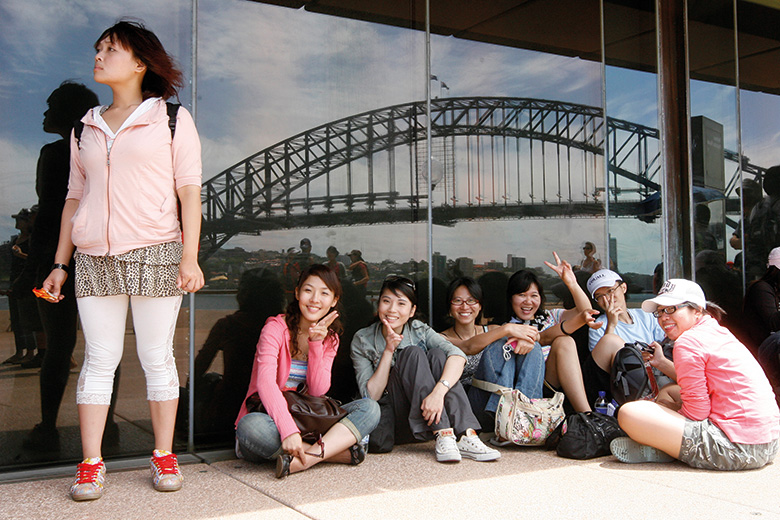
International education is Australia’s third-largest export industry, worth more than A$20 billion in 2015-16. Yet political and public opinion is also somewhat ambivalent about further expansion. The country has not been entirely immune to the rise of nationalistic populism: the leader of the One Nation anti-immigrant party, Pauline Hanson, won a seat in Australia’s senate last year after years in the political wilderness, for instance. And a whiff of that mood can perhaps also be seen in the government’s announcement in April that it would abolish the 457 visas for skilled temporary workers and remove 200 job titles from medium-term visa eligibility lists, including life scientists, civil engineers, historians, microbiologists and archaeologists.
About 2,000 Australian academics are employed on 457 visas, and universities are worried that the move could hamper international PhD students’ chances of gaining employment in Australia when they complete their theses. Immigration Department figures appear to show that only about 6,000 international students switched to 457 visas when their studies ended in 2016, and Universities Australia says the government has assured it that “the changes are not intended to deter the best and brightest academic talent – including the world’s leading new PhD graduates – from contributing their unique skills to Australia’s innovation agenda and future national prosperity”.
Still, the announcements made negative headlines in India: a country that has still not forgotten a series of violent attacks on Indian students between 2008 and 2010. Combined with a crackdown on financial requirements for international students, amid fears that some were using study at low-quality providers merely as a route to permanent residency, the attacks led to a sharp fall in the number of Indian students coming to Australia. That fall has since been reversed but the current prime minister, Malcolm Turnbull, has also announced a tougher route to citizenship as part of plans to “stand up for Australian values” – a move that was criticised in some quarters as an opportunistic bid to bolster his flagging poll numbers.
In Sydney, overseas students – particularly those from China – have also been caught up in debates over the increased unaffordability of house prices, which rose 16.5 per cent in the past 12 months and have doubled in absolute terms since 2009, according to Demographia’s 2017 Housing Affordability survey. According to the ABC, that survey rated Sydney as the second most expensive city in the Western world – Melbourne is sixth, with prices up 89 per cent since 2009 – while research by Credit Suisse indicates that foreigners buy 25 per cent of all new housing supply in New South Wales and 16 per cent in Victoria, with China accounting for 80 per cent of overseas sales.
Many parents of university students in Sydney’s affluent northern beachfront suburbs wonder whether their country is really benefiting from the influx of international students when their offspring are unable to buy a home in their home city.
“My daughter and her husband want to buy a house but whenever she goes to an auction she is blown out of the water by Chinese buyers,” says one retired academic from Sydney. “Foreign students are obviously important to the finances of our universities, but will these students stay on here to become the doctors, teachers, local politicians and community volunteers that civic society needs?”
Another resident describes how her medical student son was one of the few white Australians to sit his final year exams at a Sydney university last year. Many of his classmates were the Australian-born children of Indian and Asian immigrants, who often outperform white Aussies in the school system.
The high concentration of Asian students in courses such as medicine, science, engineering and business studies can have “adverse consequences”, admits Bebbington. These include “a reaction from the Australian students to being in the minority, but also a loss of the Australian experience that the international students came here to have. A challenge for our universities is to diversify their international students across their programmes.”
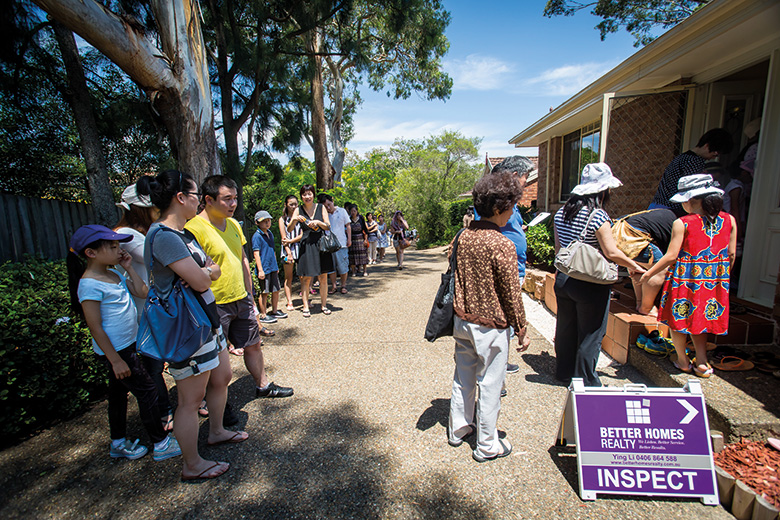
As a nation, Australia is still reluctant to talk about issues around race, says Michael Spence, vice-chancellor of the University of Sydney, Australia’s oldest university, where 35 per cent of students are from overseas.
“When it comes to diversity, Australia is at best schizophrenic – we are the most ethnically diverse democracy in the world but we are also a country that, until the 1970s, had white Australia policies,” says Spence, who headed the University of Oxford’s law and social sciences division before returning to Australia to take charge at Sydney in 2008.
Spence, who speaks Chinese and is married to a Korean, is arguably more attuned than many in his position to some of these fraught issues, and he is keen to prevent the “high levels of social isolation” that students from different ethnic backgrounds can suffer.
Increasing interaction between Asian and Australian students is one of the drivers behind an overhaul of Sydney’s undergraduate curriculum, which will offer a new four-year bachelor of advanced studies from autumn 2018. This will see students from different disciplines work together on an “advanced coursework” project, focusing on real industrial or academic research challenges. This will not only improve teaching and students’ career prospects but boost cohesion between different groups of students by “breaking down boundaries between their social and academic lives”, Spence says.
He is also keen to see more students of Asian origin within the faculty of Australian universities. “People from East Asian families are doing very well in our education system but they are massively underrepresented [within academia],” he says, adding that this “bamboo ceiling” is “something we do not like to talk about” in higher education. “There are 39 vice-chancellors in Australia but only one is not from a North European ethnicity. [There is] not a whole world of difference if you look at heads of schools or departments.”
Spence is concerned that many Australian-educated graduates have chosen to make their mark in Hong Kong, Singapore or China, rather than contributing to research efforts in Australia. He attributes this to “really mean policies” from the past, such as cutting off access to internships for international medical students, which alienated talented graduates who might otherwise have settled.
“Not many people live in Australia, so we need to import clever people and get full access to the global talent pool,” he says.
Adelaide’s Bebbington notes that 60 per cent of international students still return to their home countries when they finish their studies. Hence, “growing the number of Asian senior faculty is a long-term project. But Australia has among the most generous provisions of any country for graduating international students to stay on and work,” he says.
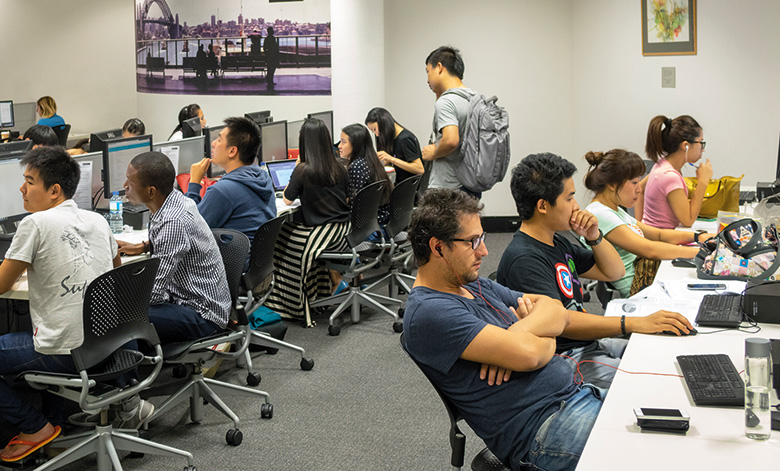
One Asian academic who excelled within the Australian system is Max Lu. In 1994, the chemical engineer joined what was then a mere “handful” of Chinese academics at the University of Queensland in 1994. But by the time he left the Brisbane institution in April 2016, having risen to become its provost and senior vice-president, it had recruited many Chinese postgraduates, postdoctoral researchers and permanent faculty.
“As the reputation and quality of research in China has risen, we are now starting to see researchers head in both directions,” says Lu, who is now president and vice-chancellor of the University of Surrey: the first China-born scholar to head a major university in the UK, US or Australia. In January he also became an officer of the Order of Australia – the country’s second-highest honour – for his services to education and Australia-China relations.
“We are starting to see genuine multilateral cooperation that leads to true partnership,” he says, predicting that with the “economies of East Asia and Australia increasingly intertwined”, this cooperation will accelerate in coming years – particularly given Australia’s “strategic importance” as a resource-rich country.
Another aspect to Australia’s growing importance in the Asian market is the region’s growing prosperity, vast numbers of young people and relative paucity of high-quality research-intensive universities. For instance, while the Indian Institutes of Technology may boast stellar reputations – thanks in part to the success of some famous alumni, such as Microsoft boss Satya Nadella – their capacity is “tiny”, according to Arun Sharma, deputy vice-chancellor for research at Queensland University of Technology and the former head of the University of New South Wales’ computer science department.
“All the IITs in India combined produce fewer computer science graduates a year than my class at New South Wales. India will find its own solution eventually but, at the moment, demand and supply have never been quite so at odds,” he says.
Online education might be one of the answers, with Australian institutions developing new hybrid models that might unlock the Indian market. The University of New South Wales, for instance, has partnered with King’s College London and Arizona State University to create the PLuS Alliance (taken from the locations of the three universities: Phoenix, London and Sydney), which the institutions believe could provide programmes for more than 100,000 students via a blend of online and campus-based learning.
The other salient factor in all of this is economics. Australia’s mineral-led economic boom led it to set a new record in June for successive periods of economic growth: 103 quarters without consecutive falls in GDP. Many universities feel that they have not seen the benefits of it, with declining per-student funding and the government apparently set on imposing cuts. Despite this, uncapped domestic enrolments, funded by student loans, and the influx of international students has provided universities with a financial boon.
“We refurbished 35 major teaching spaces last year alone,” explains Peter Coaldrake, vice-chancellor and chief executive of QUT, speaking a few yards away from the 50m indoor Olympic swimming pool that sits beneath the institution’s student centre at its Gardens Point campus, opened in 2014. Infrastructure improvements have been even more dramatic at QUT’s Kelvin Grove campus since Coaldrake took over in 2003, with aerial photos showing how acres of barren scrubland with a few university buildings have been transformed into a bustling student hub.
Recently announced government plans to raise student fees, lower repayment thresholds and cut state funding by 2.5 per cent, however, are just the latest round in a long series of proposals to lower the state’s contribution to higher education further. In that environment, Australian universities have little option but to count on buses like the 891 bearing even higher numbers of international students to their campuses in future.
But the 891 bus itself could soon be history. The route could become obsolete when a new light railway to Randwick opens in 2019. While some Australians might bridle at the social and pedagogical impact of more international students, such tangible benefits of a huge export industry are undeniable.
